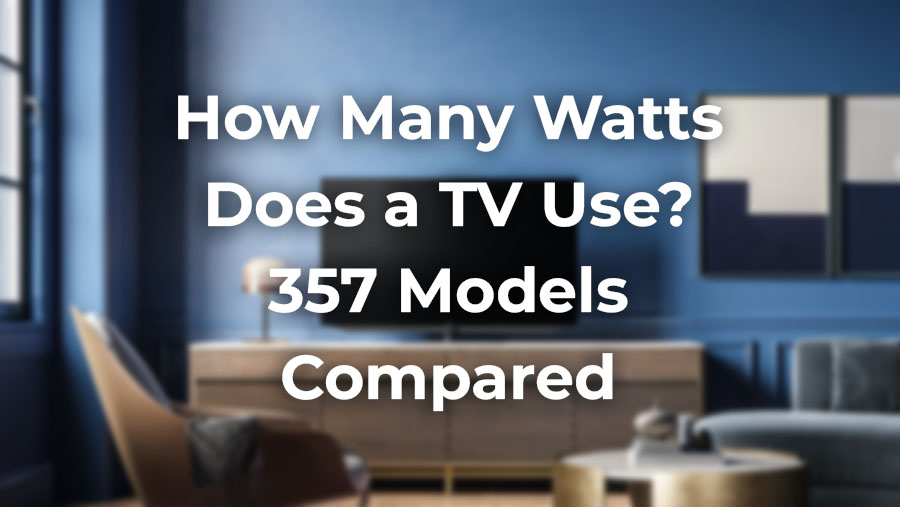As energy prices are predicted to keep rising over time, it’s a good idea to keep your energy consumption as low as possible.
One easy way to do that is to use devices that need less power to operate. Unfortunately, TVs are among the home appliances that consume the most electricity.
The good news is that you can save a significant amount of money over time if you think ahead and choose a TV that consumes less wattage.
We compared 357 different TV models and synthesized all the relevant data in an easily digestible format to give you a really helpful and practical overview of the energy usage of TVs.
Here’s what we’ve found:
How Much Electricity Does a TV Use On Average?
According to our study, the typical power consumption of a TV is 87.4 watts on average while in standby mode most TV models use 0.5 watts or less. The average annual energy consumption is 169.8 kWh, however, the actual numbers very much depend on the screen size, resolution, and other features of the TV.
Average TV Wattage Consumption By Screen Size
Screen size is one of the most important considerations when choosing a new television. Let’s see how the diameter of the screen influences the average power usage.
| Power Consumption (watts) | ||
| Screen Size (inches) | On Mode | Standby Mode |
| 39″ and smaller | 28 W | 1.3 W |
| 40″-49″ | 51.8 W | 1.6 W |
| 50″-59″ | 84.2 W | 1.7 W |
| 60″-69″ | 130.4 W | 0.55 W |
| 70″-79″ | 151.9 W | 0.92 W |
| 80″+ | 150.4 W | 0.5 W |
Here’s a more detailed breakdown of the average wattage consumption:
- A 19-inch TV uses 16.3 watts of electricity per hour.
- A 24-inch TV consumes 24.3 watts.
- A 32-inch TV uses 29.5 watts of electricity.
- A 39-inch TV uses 34.8 watts.
- A 40-inch TV consumes 34.2 watts.
- A 43-inch TV consumes 53.1 watts.
- A 50-inch TV uses 77 watts.
- A 55-inch TV consumes 98.6 watts of electricity.
- A 58-inch TV uses 82 watts.
- A 65-inch TV uses 130.3 watts.
- A 75-inch TV consumes 151.4 watts.
As you can see, larger screens are associated with higher average power consumption in “on” mode but not in standby mode.
In our study, the energy consumption ranges were the following (on mode):
- 39″ and smaller: from 15 to 50 watts
- 40″-49″: from 33 to 100 watts
- 50″-59″: from 59 to 240 watts
- 60″-69″: from 73 to 300 watts
- 70″-79″: from 82 to 340 watts
- 80″ and larger: from 92 to 249 watts
The above data shows why informed buying is so important when it comes to saving energy.
Often there’s a threefold difference (or even more) in energy consumption between LED LCD TV models with the same or similar screen sizes.
Average TV Wattage Consumption By Resolution
Now let’s move on and see how resolution influences the average electricity consumption. The resolution of the TVs we studied ranged from 720p to 4320p.
| Power Consumption (watts) | ||
| Resolution | On Mode | Standby Mode |
| 720p | 28.2 W | 1.4 W |
| 1080p | 36.3 W | 0.5 W |
| 2160p | 101 W | 1.1 W |
| 4320p | 222 W | 0.5 W |
As you would expect, the more pixels, the higher the energy consumption is in “on” mode. However, that’s not true in standby mode.
Let’s have a look at the ranges:
- 720p (HD): from 15 to 50 watts
- 1080p (Full HD): from 19 to 75 watts
- 2160p (4K): from 46.4 to 340 watts
- 4320p (8K): from 175 to 249 watts
This is further proof of significant differences between television models with similar features.
As an example, if you need a 75-inch 4K LCD TV, you can find one that consumes as low as 82 watts but you can easily end up buying a model that uses 340 watts or more.
That’s an astonishing fourfold difference between two smart TVs. Energy efficiency is not true for all models.
Of course, some extra features often require more power, however you need to consider if those are worth the additional energy cost.
Average Annual Power Consumption By Screen Size
On most TVs, you’ll find an Energy Guide label that will show you the expected yearly electricity use of the model. That’s a calculated number based on 5 hours of use per day.
Actually, it’s a really useful parameter if you want to compare different TV models. It also helps you to calculate the estimated yearly cost of a model (click here to jump to the electricity cost calculator).
| Screen Size (inches) | Annual Power Consumption (kWh) |
| 39″ and smaller | 50.4 kWh |
| 40″-49″ | 97.4 kWh |
| 50″-59″ | 150.9 kWh |
| 60″-69″ | 223.8 kWh |
| 70″-79″ | 292 kWh |
| 80″+ | 348.6 kWh |
Similar to “on” mode power consumption, annual energy use is associated with screen size:
The larger the screen, the higher the yearly electricity consumption.
Here are the ranges:
- 39″ and smaller: from 28.8 to 67 kWh
- 40″-49″: from 63.5 to 192 kWh
- 50″-59″: from 92 to 280 kWh
- 60″-69″: from 144 to 403 kWh
- 70″-79″: from 160 to 625 kWh
- 80″ and larger: from 178 to 884 kWh
The annual energy consumption values range widely in all categories, the upper value is always several times higher than the lower value.
As a consequence, you can save a considerable amount of energy and money each year if you choose your TV carefully.
Average Annual Power Consumption By Resolution
Here’s how average electricity consumption varies as the number of pixels increases:
| Resolution | Annual Power Consumption (kWh) |
| 720p | 50.3 kWh |
| 1080p | 68.9 kWh |
| 2160p | 189.8 kWh |
| 4320p | 493.9 kWh |
The ranges are the following:
- 720p (HD): from 28.8 to 67 kWh
- 1080p (Full HD): from 38.1 to 104 kWh
- 2160p (4K): from 87.5 to 730 kWh
- 4320p (8K): from 335 to 884 kWh
According to the aggregated data, the average annual energy use of an 8K TV is more than 7 times that of a full HD TV and 2.5 times that of a 4K TV.
Also, a 4K TV consumes approximately 2.7 times more power per year than an average full HD TV.
Median Power Consumption Values
The median is the middle number in a set of numbers. Compared to the average, the median often gives you a more accurate estimate of a value within a category.
Median Energy Use By Screen Size
| Screen Size (inches) | Typical Power Consumption (watts) | Annual Power Consumption (kWh) |
| 39″ and smaller | 26.8 W | 51 kWh |
| 40″-49″ | 51 W | 97 kWh |
| 50″-59″ | 78.8 W | 149.6 kWh |
| 60″-69″ | 101.9 W | 195 kWh |
| 70″-79″ | 117 W | 217 kWh |
| 80″+ | 143 W | 308 kWh |
Median Energy Use By Resolution
| Resolution | Typical Power Consumption (watts) | Annual Power Consumption (kWh) |
| 720p | 26.8 W | 51 kWh |
| 1080p | 34.9 W | 65.9 kWh |
| 2160p | 89 W | 167 kWh |
| 4320p | 229.5 W | 436 kWh |
Relationship Between Screen Size and Power Consumption
As you can see, there’s a positive correlation between screen size and annual power consumption:
However, as the screen size increases, the power consumption range becomes wider and wider.
For this reason, you need to consider your choice because the electricity use of different models in the same category varies significantly.
The same is true for the typical wattage consumption:
Relationship Between Resolution and Power Consumption
The correlation between resolution and power consumption is positive. As a rule of thumb, the higher the resolution the more you pay for electricity.
Again, there are pretty significant differences between the models in the same category, so it’s definitely worth the time to check the Energy Guide of a given TV.
How to Calculate the Estimated Energy Cost of a TV?
To calculate the estimated electricity cost of a TV, you’ll need the wattage, the usage time, and the energy price.
Here’s the formula:
wattage x usage time (number of hours per day) x 365 / 1000 x energy price
For example, if a TV consumes 89 watts/hour and you use it 5 hours a day, assuming the energy price is 15 cents per kWh, the estimated annual energy cost is the following:
89 x 5 x 365 / 1000 x 0.15 = $24.4
Here’s a handy calculator to make things even simpler:
Popular Energy Efficient LED TV Models
| Model | Screen Size | Resolution | Power Consumption | |

| Samsung - UN40N5200AF | 40 inches | 1080p | 30 watts |

| Samsung - QN50Q60AAF | 50 inches | 2160p | 54 watts |

| LG - 50UM7300AUE | 50 inches | 2160p | 60.6 watts |

| LG - 55UP8000PUR | 55 inches | 2160p | 77.5 watts |

| Samsung - QN65Q60AAF | 65 inches | 2160p | 79 watts |

| LG - 75UN7070PUC | 75 inches | 2160p | 110 watts |
| Samsung - QN85QN90AAF | 85 inches | 2160p | 121 watts |
FYI: When choosing a TV for the elderly, besides energy consumption you need to consider several other factors. In this helpful guide, I have summarised the most important things to know.
Electricity Consumption By TV Models
Below you'll find a table with a list of TV models and their power consumption data.
So, Does a TV Use a Lot of Electricity? Wrapping It All Up
Most modern LED smart TVs are way more energy efficient than older models (not to mention plasma TVs). Therefore, if you’re planning to buy a new television, you have the opportunity to choose from a bunch of eco-friendly models.
However, don’t let the wide range of energy-efficient TVs fool you. Unfortunately, there are still some real energy guzzlers on the market, some of which may have a higher running cost than a refrigerator. By the way, we have a similar article about fridge energy consumption, in which we analyzed and compared 2967 models.
It’s useful to know that there are substantial differences between TV models regarding wattage consumption. Thus, you always need to read carefully the Energy Guide of a TV and check how it compares to other models in the same category.
Energy Star certified TVs save significantly more energy than conventional models, therefore if you want to reduce energy costs, I suggest you choose an Energy Star qualified television.
If low energy consumption and low electricity bill are top priorities for you, eco mode is another feature you should look for.
Data sources: Samsung, LG, Energystar, Sony, Hisense, TCL, Sceptre, Toshiba, PHILIPS











